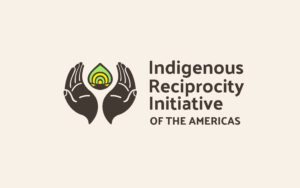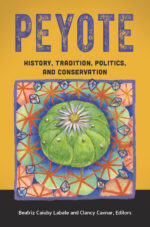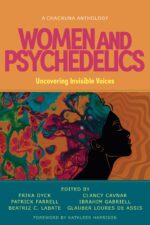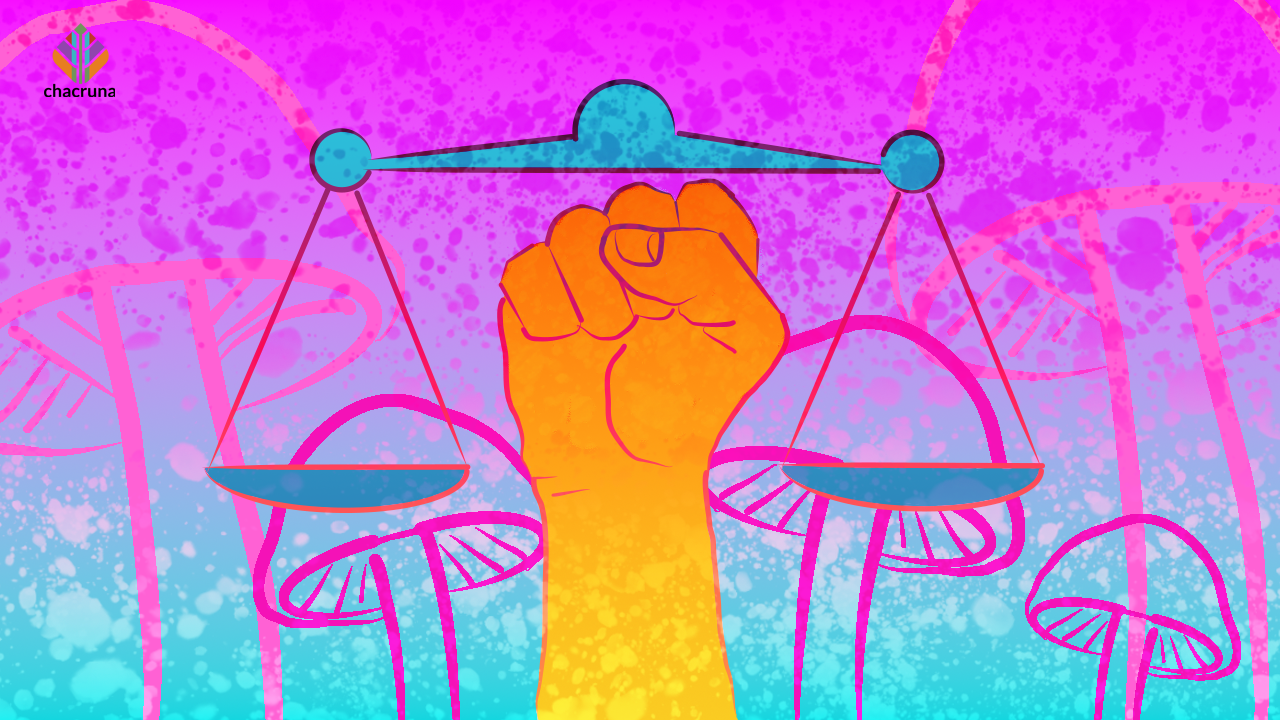I recently had the opportunity to participate in the Chacruna Institute’s “Diversity, Culture and Social Justice in Psychedelics” course, a transformative experience filled with ripe opportunities to critically examine and evolve my belief system. The ten weeks I got to spend self-reflecting, discussing with dedicated and open-minded students, as well as learning from a group of wise lecturers left me with many insights. For one, I have greater knowledge of what is happening in the “Psychedelic Renaissance” beyond the mainstream narrative of psychedelics as a panacea, and I have refined my comprehension of what it means to be an ally in this movement. My approach to plant medicine ceremonies has also evolved as a result, exemplified by a recent poignant encounter with ayahuasca, elaborated upon below.
Throughout this article, I opt to use the term “psychedelic and earth medicines” (PEM) to encompass plant medicines (such as Ayahuasca, Huachuma, Rapé, etc.), fungi medicines (such as Psilocybe and Amanita Muscaria mushrooms), animal medicines (such as Bufo Alvarius), and synthetic compounds (such as LSD, MDMA, synthetic DMT, synthetic psilocybin, etc.). I chose to do so as I do not feel that the term “psychedelic” (“mind-manifesting”) is a fair nor appropriate term to describe the earth’s natural and intelligent plant, fungi, and animal medicines, and worry that characterizing them as “mind manifesting” and lumping them with other synthetic compounds strips them of their essence as plant teachers with agency, consciousness, and intelligence.
1 – The “Psychedelic Renaissance” Needs Systems Thinking, a History-Informed Lens, and the Centering of Indigenous Knowledge Systems and Voices
PEMs, despite holding tremendous potential for individual and social change, are no cure-all. While many positives have come from the West’s “psychedelic renaissance,” particularly regarding these medicines’ potential to revolutionize mental health care, there are also inequities and risks inherent to the movement that we must not keep in its shadows but bring to the forefront. As Dr. Glauber Loures de Assis warned, we are deluded if we think that we are one psychedelic family and lumping us together like this is dangerous. The recent explosion of interest in PEM is mostly coming from Western societies born from colonization, as well as fraught with systemic societal ills such as racism, white supremacy, patriarchy, extractive capitalism, hyper-individualism, and an ongoing legacy of epistemic colonialism. Thus, just as how a fish swimming in mercury-contaminated water will naturally become contaminated, the PEM movement is not immune to the West’s societal ills.
We must thus consider how these issues are also infiltrating the PEM movement and put in place measures to address the inequities that have already resulted as a consequence, such as the underrepresentation of BIPOC in all facets of the movement (in terms of study participants, facilitators, and more). If we fail to do so, we risk perpetuating the same stories of racism, colonization, and anthropocentrism that Western societies were born from. This can and will have severe repercussions on all communities that have been structurally oppressed, as well as the plants themselves that are already being extracted, deterritorialized, commodified, and ultimately stripped of their very essence.
IF PEMS MAKE US MORE CONSCIOUS, WE MUST EXTEND THIS AWARENESS OUTSIDE OUR IMMEDIATE SELVES AND LOOK AT WHAT IS HAPPENING ACROSS THE WHOLE MOVEMENT. IT BECOMES OUR RESPONSIBILITY TO THINK IN TERMS OF SYSTEMS RATHER THAN MERELY IN TERMS OF SELF.
If PEMs make us more conscious, we must extend this awareness outside our immediate selves and look at what is happening across the whole movement. It becomes our responsibility to think in terms of systems rather than merely in terms of self. As expressed by Dr. Joseph McCowan, we must see the truth: the psychedelic renaissance is deeply intertwined with other movements for civil rights, social justice, and health equity. Plus, as he warned, we must not have tunnel vision by being too focused on the liberation of the drugs themselves that we forget the importance of systems thinking, a lens that views problems as part of an overall system rather than in isolation. If we fail to think in terms of systems, we risk ending up in conundrums such as when the “Decriminalize Nature” movement, despite its good intentions, ended up causing harm to the Native American Church as the movement threatened their relationship with Peyote.
We must also mainstream a history-informed lens among PEM scientists, facilitators, and guides. Before this course, I had never heard about the dark parts of PEM history despite the numerous documentaries I’ve watched, the many books I’ve read, and the conferences I’ve attended. I was shocked to hear of the unethical, forceful use of LSD on predominantly unwilling Black participants in the CIA’s MK Ultra experiments, as well as Dr. Clancy Cavnar’s sharing about the weaponization of LSD in conversion therapy. We must not also forget the weaponization of the War on Drugs to mass incarcerate Black people in America and the impacts this has on Black communities to this day, as illustrated by Sia Henry, J.D., which contributes to communities of color being the least willing and having the least access to PEM.
Yet, we must also consider how PEM can heal these social ills moving forward. As Dr. Monnica Williams foundational work demonstrates, PEMs hold the potential to help heal racial trauma if done under the right circumstances. Furthermore, as Dr. Darron Smith and Dr. Sonya Faber explained, racism is not gone; it is just more subtle and unconscious, and implicit aversive racism leads to reduced levels of empathy between Black patients and white providers. We can also see that white supremacy has infiltrated the PEM space in the way that white academics are typically portrayed as heroes in the “renaissance,” and white people are the ones amassing the most benefit from the movement. Thus, there remains a lot of work to be done among PEM researchers and practitioners regarding racism, which is not something from the past but a force that has seeped into the fabric of our society to this day.
Finally, the perceived superiority of Western knowledge systems and the more prominent platforms given to academics over the Indigenous knowledge keepers – in which most of the medicines are rooted – should evoke a deep call within us to analyze why that is the case. We must be willing to free our minds from the “colonizer’s worldview” that assumes the universality and superiority of Christian, Euro-centric, Western scientific knowledge. I sincerely appreciated the readings and lectures that dove into some of the Indigenous knowledge systems, such as Dr. Ligia Duque Platero’s lecture on the Yawanawa’s use of forest medicines. I hope to increasingly see Indigenous knowledge centred in mainstream books, documentaries, conferences, and research and call it out when it is not the case.

Shop our Collection of Psychedelic T-Shirts
2 – Allyship: A Sense of Responsibility (“Response-Ability”) to All My Relations
This course has helped me grasp that we are indeed at a pivotal moment in PEM history as PEMs become increasingly decriminalized and legalized and as global interest in them skyrockets. Yet, as outlined above, those aware of the risks inherent in this have a profound responsibility to move forward with sensitivity, integrity, and respect and act as allies to all those whose livelihoods are affected by the “psychedelic renaissance.” The Western PEM collective must think critically, holistically, and long-term as we make decisions that can shape the future of PEMs and mental health care.
This course has helped me see the many privileges that I hold as a White, cis-gender, able-bodied, middle-class woman living in Canada. As I live without many of the challenges confronting structurally oppressed communities, such as racism, violence, and economic instability, I recognize that I have the privilege of being “able to respond” to such injustices (“response-ability”). I must take accountability for changing the patterns that have left me with these unearned privileges, and it is my responsibility and duty to be an ally to those who have not earned these same privileges. Thanks to the Indigenous wisdom shared in this course, as well as in some novels I’ve read over the past year on Indigenous spiritualities, I’m slowly beginning to understand that allyship is not just about taking action, though civil courage is a fundamental piece of it. Being an ally also means being willing to look at my own internalized biases and emancipating myself from them, as well as decolonizing my mind from the Western worldview, specifically regarding the hyper-individualism at its core.
“All my relations” is an expression rooted in North American Indigenous communities that encompasses the interconnectedness at the core of their worldviews. According to Saulteaux/Métis visual artist Autumn Whiteway, it serves as a reminder that we all live within a larger system of relationships and must maintain balance and harmony with all other real and perceived spiritual beings with whom we share this world. This course has taught me that to be an ally means to shift my perspective from thinking about “I” to thinking about “all my relations.” The interconnected nature of everything means that every decision I make will influence my kin. Thus, every decision cannot just be about what benefits me personally; to think that is illusory and a mere product of Western individualism.
THIS COURSE HAS TAUGHT ME THAT TO BE AN ALLY MEANS TO SHIFT MY PERSPECTIVE AND THINK IN TERMS OF “ALL MY RELATIONS.” THE INTERCONNECTED NATURE OF EVERYTHING MEANS THAT EVERY DECISION I MAKE WILL INFLUENCE MY KIN. THUS, EVERY DECISION CANNOT JUST BE ABOUT WHAT BENEFITS ME PERSONALLY; TO THINK THAT IS ILLUSORY AND A MERE PRODUCT OF WESTERN INDIVIDUALISM.
To illustrate an evolution of my thinking from “I” to “we,” I will describe my recent experience in an ayahuasca ceremony in the following section, where I approached the plant teacher from a different perspective than I typically would as an individualist. Instead of merely setting an intention for my self-healing, I asked the plant if she could help me heal my family.

Discover the Indigenous Reciprocity Initiative of the Americas
3 – A Kindelic Experience with Ayahuasca: Healing My Lineage
I strongly resonated with Dr. Loures de Assis’ perspective of PEMs as “kindelics.” Though the mainstream narrative is mainly focused on scientifically proving that PEMs can foster individual healing, the history of PEMs tells a different story of their potential for collective healing. For instance, I was surprised to learn that ayahuasca was used traditionally among Amazonian communities not only for healing but also to deal with issues confronting the entire community (e.g., finding food). Following Dr. Loures de Assis’ lecture, I decided to approach an upcoming ayahuasca retreat with this perspective of “kindelics.”
A month before the lecture, my beloved maternal grandmother unexpectedly passed away, which brought up a lot of grief and fear inside of me. I’ve always struggled with a deep fear of death and illness, and after she transitioned, I began to notice that some of my other immediate and extended family members were sharing their worries about this, too. I even heard from my grandmother’s brother that their mother (my great-grandmother) was afraid of death and couldn’t let go at the end of her life. I was starting to understand that this was ancestral trauma that I and my family members were carrying. Knowing I was going to sit with ayahuasca and wanting to use this opportunity to heal our fear of death, I asked her if we could work together to help the whole lineage heal. Plus, through a diagnostic with mapacho, the Shipibo maestro who led the ceremony told me that I had an ancestor’s spirit attached to me. I knew that healing wasn’t just going to be about me anymore.
Though it is difficult to describe my experience, the best way I can describe it is that I felt all my maternal ancestors’ fears were being processed through my body on behalf of the whole lineage. I was terrified, shaken, and in deep physical pain. I also felt that my grandmother’s spirit was coming to visit me. I woke up from the experience and immediately called my mother to share the experience with her, and she shared with me that she had a big realization of her own in the night about her parents. I’ve also since shared the experience with my sister, which has helped her see that her fear is not of her own doing but inherited. She is actively working on taking action to let the fear go.
I am tremendously grateful for all the speakers, readings, and students from whom I have learned (and unlearned) throughout the semester. This course and reflection have left me with an important insight: that I have a deep responsibility to think in terms of systems and kinship as a part of the PEM movement. I must remain a humble student to the plant teachers, an ally to their Indigenous stewards, and an advocate for the decolonization of the “psychedelic” movement. This will be a lifelong journey.
Art by Mulinga.
Take a minute to browse our stock:
Did you enjoy reading this article?
Please support Chacruna's work by donating to us. We are an independent organization and we offer free education and advocacy for psychedelic plant medicines. We are a team of dedicated volunteers!
Can you help Chacruna advance cultural understanding around these substances?


















